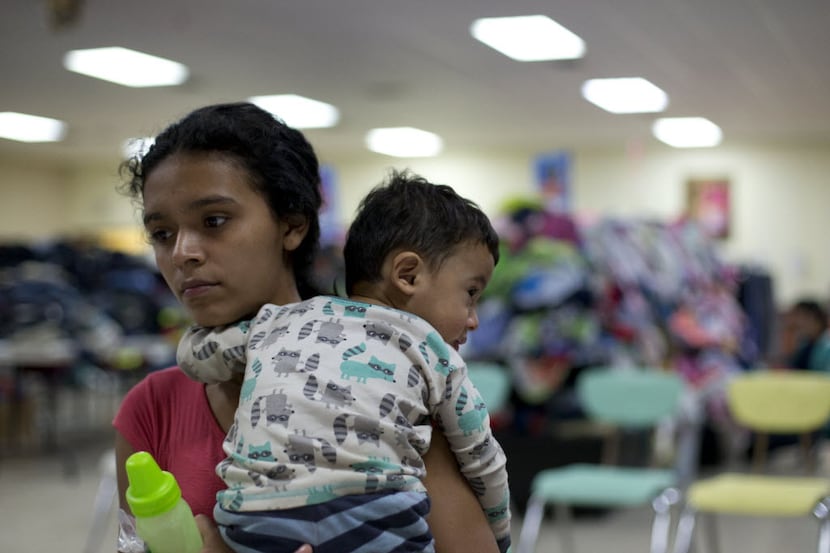The tide of migrant families with minors and children traveling alone to the U.S., mostly from Central America, has equaled the surge of 2014 that nearly overwhelmed Border Patrol resources, federal immigration officials said Monday.
U.S. Customs and Border Protection officials said they detained 137,366 migrants in those two categories in the fiscal year that just ended. Slightly fewer, 136,983 migrants, were detained in fiscal 2014.
That was when White House officials deemed the flow a "surge" and a humanitarian crisis. Experts say violence is spurring more people to flee their homelands in El Salvador and other parts of Central America, especially women and children.
"Far fewer Mexicans and single adults are attempting to cross the border without authorization, but more families and unaccompanied children are fleeing poverty and violence in Central America." — Jeh Johnson, DHS
The release of the new migration numbers comes just three weeks before the presidential election, in which immigration issues and border issues with Mexico have played prominently in the campaign of Republican nominee Donald Trump.
The new apprehensions also underscore a dramatic change in migration, noted by Jeh Johnson, head of the Department of Homeland Security: Mexicans no longer make up the majority of border apprehensions, and the demographics of unauthorized migrants on the nation’s southern border have changed significantly over the last 15 years.
“Far fewer Mexicans and single adults are attempting to cross the border without authorization, but more families and unaccompanied children are fleeing poverty and violence in Central America,” Johnson said.

Johnson noted that in 2014, Central Americans caught at the border outnumbered Mexicans for the first time. “In 2016, it happened again,” Johnson said in a written statement.
The renewed tide of migrants from the Central American countries of El Salvador, Honduras and Guatemala reflects the deepening violence there, experts say. They also say poverty and the desire to reunite with family members already in the U.S. are factors.
"The causes of migration haven't changed at all," said Wendy Young, the president of Kids in Need of Defense, or KIND.
"They kill people all the time." — Honduran immigrant Glenda Flores.
And because the U.S. government has encouraged the Mexican government to crack down by apprehending and deporting Central American migrants in Mexico before they reach the Texas border, “You could argue that the overall migration crisis is more urgent than it was in 2014.”
Young says many of those crossing from Central America should be considered potential refugees, rather than economic migrants, or people moving north primarily for jobs. Migrants who get refugee status have legal authorization to be in the U.S. Many of those spilling across the border have applied for legal status under joint refugee and asylum laws.
"The numbers show Central Americans continue to flee," said Maureen Meyer, senior associate for Mexico and migrant rights at the Washington Office on Latin America, or WOLA.
["Not Found"]
Meyer said record levels of violence, especially in El Salvador, are driving people north. Other migrants are coming from other nations in the so-called northern triangle of Central America, Guatemala, El Salvador and Honduras.
"Central America's Northern Triangle region is among the most violent in the world. In 2015, El Salvador's national homicide rate reached approximately 103 homicides per 100,000 people, making it the murder capital of the world," said the Trail of Impunity report produced with other nonprofits and released by WOLA last month.
The report notes that 2016 may be the year Mexico has the highest-ever number of detentions, deportations and asylum requests.
The number of migrants heading north from Central America may actually be greater than in 2014 because Mexico has been pressured by the U.S. to stem the tide at its own borders. In 2015, Mexico intensified its policing of unauthorized migration.
Mexican deportation statistics show that for the first 11 months of fiscal year 2016, about 30,000 minors were sent back to Guatemala, El Salvador and Honduras.
The additional efforts to turn people back mean those who run human trafficking networks are getting ever more clever, Meyer said.
“This increase is more a sign of migrants and coyotes figuring out how to get around enforcement,” she said.
But the overall number of migrants caught at the border — 408, 870 — is still only about a fourth of the 1.6 million high in fiscal year 2000. “Across the board, apprehensions are much lower than ever. We are at levels of the mid-1970s,” Meyer said. “There isn’t a flood.”
The system is instead being strained by the number of Central American women and children who are seeking asylum or some sort of safety.
The increasing numbers of Central Americans have had an impact on the nation's immigration courts. Those courts face a record backlog of 512,000 cases. More than a quarter of those cases are for unaccompanied minors and adults, usually women traveling with minors, according to data collected by the Syracuse University-based Transactional Records Access Clearinghouse, or TRAC.
In Dallas, the number of immigration judges has been increased from five to six to help with greater caseloads.
As a result, it now takes an average of 452 days, or about 15 months, for a case to move through the courts, where the national average had been as high as 712 days, or nearly two years, TRAC data shows.
Among new arrivals this year to the Dallas area is Glenda Flores. She came north with her 12-year-old daughter and her 4-year-old son from Honduras, entering the U.S. in the Rio Grande Valley.
Honduras is simply too violent, she said. "They kill people all the time," said Flores, who is fighting her deportation case by asking for asylum.
Johnson said border security alone can't overcome powerful factors like violence and poverty that are pushing people north from Central America.
"Ultimately, the solution is long-term investment in Central America to address the underlying push factors in the region," he said.

